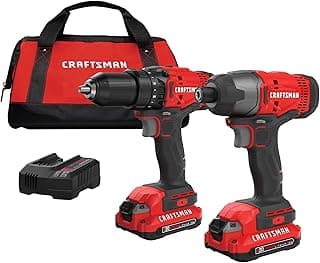Top Picks
Best Precision: SpeTool Portable Drill Guide
The SpeTool Portable Drill Guide is designed for woodworkers who want drill press accuracy with the flexibility of a handheld drill. Built from durable all-metal components, it offers millimeter-level precision, smooth operation with linear ball bearings, and a wide angle range from 0 to 60 degrees. Its three-pole support system and V-block design provide extra stability for both flat and round materials, while the anodized aluminum base ensures long-lasting durability.
From a customer perspective, the tool stands out for its ability to deliver consistently straight and angled holes without the bulk of a stationary drill press. Professionals appreciate the tight tolerances and stability, while hobbyists value its ease of use and versatility. The added weight may be noticeable during transport, but it contributes to stability during operation.
Overall, this drill guide offers excellent performance and precision for woodworking projects, making it a valuable investment for users who need reliable accuracy in portable drilling.
Best Straight Drilling: Portable Drill Guide for Straight Holes
The WT116A Portable Drill Guide is purpose-built for straight-hole drilling, offering drill-press-like precision without the bulk of a stationary machine. Its chrome-plated steel guide rails, reinforced hex shank, and 1/2-inch chuck provide strength and stability, while the centering slot and V-groove make it adaptable for flat or round materials. The built-in depth stop ensures consistency across multiple holes, reducing the chance of mistakes or wasted material.
From a customer or expert perspective, this tool shines in repetitive straight drilling jobs where accuracy and efficiency matter most. Its compact size and lightweight design make it easy to carry to worksites or fit into small workshops, though it is not suitable for angled drilling, which limits versatility compared to adjustable drill guides.
Overall, the WT116A is a reliable and efficient solution for users who primarily need stable, straight holes. It offers excellent performance and durability, making it a strong value for woodworking, DIY, and construction tasks where precision and repeatability are essential.
Best Multi-Angle: 30 45 90 Degree Angle Drill Guide Jig for Hand Drill
The VASTHOME 30-45-90 Degree Angle Drill Guide Jig is designed for users who need both straight and angled drilling in woodworking and home projects. With preset angles of 30°, 45°, and 90°, it allows quick and precise hole placement for tasks such as stair handrails, decks, and cable railings. The inclusion of four common drill bits and matching guide hole sizes adds convenience, making it ready for immediate use.
From a user standpoint, this jig is highly practical for DIY and light construction projects. Its compact design makes it easy to position in tight areas, while the preset angles save time compared to adjustable jigs. However, it may not provide the same stability or wide angle range as heavy-duty drill press adapters.
Overall, this drill guide jig offers strong value for homeowners and DIY enthusiasts who frequently work on railing, decking, and wood post projects. It balances accuracy, portability, and ease of use, making it a versatile choice for angled drilling needs.
FAQs
How to drill perfectly straight holes with a hand drill?
Drilling a straight hole with a hand drill requires patience, stability, and the right technique. First, mark your drilling spot clearly with a center punch or awl to prevent the bit from wandering. Hold the drill firmly with both hands and start at a slow speed to let the bit bite into the surface. Keep your wrist and elbow aligned with the drill’s body. For the best results, using a drill guide or a simple homemade jig can help maintain accuracy and ensure your holes stay perfectly straight.
Are manual hand drills any good?
Yes, manual hand drills still hold value, especially for precision work and delicate materials. Unlike power drills, they give you full control over speed and pressure, which reduces the risk of damaging wood, plastic, or soft metals. They’re lightweight, quiet, and don’t require electricity—making them ideal for small projects, woodworking, or areas where precision matters more than speed. While they can’t replace a power drill for heavy-duty tasks, they’re a reliable tool for controlled drilling.
How to keep a hand drill level?
Keeping a hand drill level can be challenging, but a few tricks make it easier. Focus on your posture—stand directly over the workpiece and keep your eyes aligned with the bit. Using a small bubble level attachment for drills or marking reference lines on your work surface can help you stay straight. Another tip is to drill slowly at first, then increase speed as the bit anchors itself. If precision is critical, pairing your hand drill with a portable drill guide provides consistent alignment without guesswork.
How to use a portable drill guide?
A portable drill guide is designed to improve accuracy and stability when drilling. To use one, first secure your workpiece to prevent movement. Attach your drill to the guide and adjust the angle if needed—most models allow for vertical, angled, or even sideways drilling. Place the guide firmly against the surface, align the bit with your mark, and start drilling at a steady pace. The guide will keep the bit aligned throughout the process, ensuring cleaner, straighter, and more consistent holes compared to freehand drilling.






















